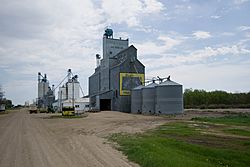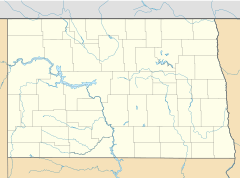Harlow, North Dakota facts for kids
Quick facts for kids
Harlow, North Dakota
|
|
|---|---|

The grain elevator in Harlow
|
|
| Country | United States |
| State | North Dakota |
| County | Benson |
| Founded | 1912 |
| Elevation | 1,644 ft (501 m) |
| Time zone | UTC-6 (Central (CST)) |
| • Summer (DST) | UTC-5 (CDT) |
| ZIP Code |
58346
|
| Area code(s) | 701 |
| FIPS code | 38-35460 |
| GNIS feature ID | 1029319 |
Harlow is a small, unincorporated town in Benson County, North Dakota, United States. This means it's a community that doesn't have its own local government like a city does. It is located in Butte Valley Township along North Dakota Highway 30. Harlow shares its Zip code (58346) with a nearby town called Leeds.
Harlow's History
Harlow was started in 1912. It grew up along the Soo Line Railroad, which was a very important railway line back then. A post office opened in Harlow in 1914. It helped people send and receive mail. This post office closed in 1984.
At one point, about 100 people lived in Harlow. Even with this many people, it never officially became a city. The town's name might have come from a railroad official. Another idea is that it was named after the Harlow Old Fort House in Plymouth, Massachusetts.
Early Settlers and Local Stories
The first person to settle the land where Harlow now stands was Louis Larsen Ulvestead in 1896. A local resident named Ole Ronning (1905-2005) lived on this original homestead for many years. He moved to Devils Lake in 2000. Ole and his wife, Alma, were well-known for writing a detailed history of Harlow and the area around it in the 1960s.
Notable People from Harlow
- Byron Knutson was an important person from Harlow. He worked in the North Dakota government.
- From 1959 to 1962, he was a member of the North Dakota House of Representatives. This group helps make laws for the state.
- Later, he was the North Dakota Insurance Commissioner from 1977 to 1980. This job involved overseeing insurance companies in the state.
- He also served as the North Dakota Labor Commissioner from 1987 to 1990. In this role, he worked on issues related to jobs and workers' rights.


